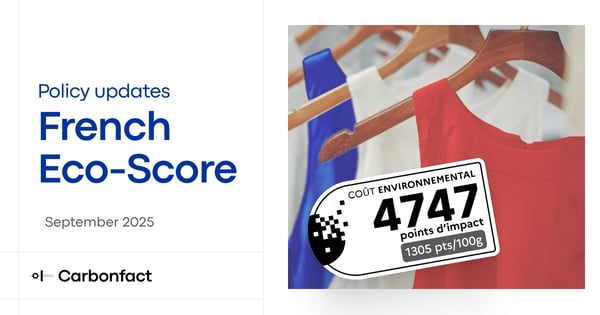With the urgent need to combat climate change and the vast potential for reducing carbon emissions, the apparel and footwear industries must take decisive action. Part #1of this blog discussed that within the fashion and apparel industry, on average, 96% of emissions stem from Scope 3 across brands with approved science-based targets (SBTs). Considering that the estimated cost of decarbonizing the fashion industry is a trillion dollars, it's crucial to recognize that suppliers alone cannot bear the weight of this transformation. To make a real difference, brands must start playing an active role in assisting suppliers in securing the necessary financing.
The task will be hard, however, this two-part blog series is a case for optimism. We can decarbonize the fashion industry. We can and we should do it fast. This will require not only scaling up and intensifying current decarbonization approaches but also reshaping the brand-supplier relationship. The #1 part of this series outlined a list of decarbonization initiatives, now let's explore specific ways brands can help suppliers decarbonize, as well as prove that it can be cost-effective to do so.
Let’s dive in!
Suppliers cannot do this alone
In the first part of this blog, we took a look at McKinsey's Fashion on Climate report, which outlines specific accelerated abatement strategies that are crucial to moving the fashion industry from the currently projected 2.7 billion tons of emissions to 1.1 billion tons per year in 2030. An important insight here is that all of the strategies can be grouped into three categories, each holding a different accelerated abatement potential - upstream operations (60% potential), the brand’s own operations (20%), and sustainable consumer behaviors (20%).
Considering this, the brand’s decarbonization efforts should be focused on the category with the biggest accelerated abatement potential: suppliers. Brands often run from this responsibility, leaving factories with no financial support or long-term order commitments. This must change. To decarbonize the entire supply chain, fashion companies must actively engage in processes such as helping factories access renewable energy or financing from banks.
Moving suppliers towards renewable energy
Helping suppliers access renewable energy can be achieved through ensuring the financial stability of factories. A closer brand-supplier relationship can support factories by making them appear more credible to financial institutions, enabling them to invest in low-carbon technology.
Under an accelerated abatement scenario, energy efficiency, and energy transition levers can deliver around 1 billion tons of GHG emissions abatement in 2030 across the value chain. Brands and retailers play a key role in supporting the energy transition of upstream operations in several ways:
Collective renewable energy projects
H&M Group and Bestseller, in collaboration with the Global Fashion Agenda (GFA), are set to construct Bangladesh's first offshore wind project. It aims to overcome various obstacles by allowing brands to invest in established development initiatives collectively. While still in its initial phases, this proposed wind farm is slated to start operations in 2028, boasting a capacity of 500 megawatts. If successful, it is anticipated to annually reduce the country's emissions by 725,000 tons. (Source: BOF)
Power Purchase Agreements
Another way that brands can help suppliers decarbonize is through Power Purchase Agreements - a long-term contract between a buyer and a renewable energy generator. The buyer agrees to purchase a specified amount of electricity from the generator, typically for a period of 10-20 years. The generator then uses this revenue to finance the construction of new renewable energy projects. Suppliers cannot finance this all by themselves; which is why fashion brands need to collectively invest in PPAs to drive this change.
Carbonfact’s thought leader Martin Daniel emphasizes: "A Purchase Agreement (PPA) can become a tool to help brands and manufacturers reduce their carbon emissions. By bringing a financial guarantee, a brand can help manufacturers access lower-cost capital. We believe it is a fair, scalable, and efficient mechanism to decarbonize material processing emissions."
Renewable Energy Certificate (REC)
NIKE: In FY22, Nike collaborated with the Clean Energy Investment Accelerator (CEIA) to introduce an innovative initiative aimed at promoting renewable energy adoption in Indonesia. Through this collaboration, Nike facilitated the implementation of a bundled REC agreement between Indonesia's state-owned electricity company and local suppliers. This program offers suppliers the opportunity to purchase a verified and traceable source of renewable electricity at a competitive fixed price for a duration of 10 to 15 years. Recognizing the time-consuming nature of developing a market-based solution like a corporate power purchase agreement, Nike identified the bundled REC program as an effective interim solution. Buyers will support the local energy market by participating in this program, thus fostering additional development of renewable energy sources within Indonesia. (Source: Nike sustainability report )
Supplier training
PUMA: In 2022, PUMA offered tailored climate training sessions for their suppliers in various geographical regions with a focus on specific regional needs. These training programs covered a range of topics including the procurement of rooftop solar systems, transitioning away from coal, and the acquisition of International Renewable Energy Certificates (I-RECs). A total of 417 participants from 243 factories took part in these training sessions. This initiative, coupled with climate action training courses provided by GIZ to suppliers, played a crucial role in expediting the deployment of rooftop solar projects, increasing the procurement of renewable energy certificates, fostering greater interest in feasibility studies for coal-fired boilers, and kickstarting efforts towards transitioning away from coal. (Source: PUMA sustainability report)
Is it cost-optimal to decarbonize?
When it comes to decarbonization, brands often have one main question: is it worth it? Let’s calculate.
Let’s first introduce a useful tool called the Abatement Cost Curve. It is widely used in consulting and has been popularized by McKinsey in a few reports since 2007. Let’s also introduce the unit of GHG measurement we will use in the rest of the post, kgCO2e.
Here’s a breakdown of this measurement:
- CO2e (Carbon Dioxide Equivalent) is the unit of measurement for the warming effect of greenhouse gasses, whether that’s carbon dioxide, methane, or nitrogen dioxide.
- 1 kgCO2e is the warming equivalent expressed in CO2e for a hundred years in the atmosphere.
- 1 ton of CO2e is thus equal to 1,000 kgCO2e.
- For reference, a typical dress emits about 22kgCO2e.
If you want to lower the carbon emissions of that dress, there are different actions a brand could take: utilize recycled fabric, help suppliers install solar panels to power their machines or opt for a less resource-intensive coloring technique.
All those initiatives have a cost and a potential. The cost is expressed in the amount of dollars to avoid 1 ton of carbon emissions. The potential is expressed by the total tons of CO2e you could save by implementing that initiative. To give you an order of magnitude, the cost of 1 ton of CO2e on the European market is ~$100 at the time of writing.
With those two axes, we can then compare initiatives. Some will be tall and thin rectangles, meaning expensive with small potentials. Others will be larger and smaller meaning cheaper cost for carbon reduction.
We can then rank those rectangles by ascending cost. You end up with a nice abatement cost curve.
Do you notice the left side of the chart? Those are initiatives that would both save money AND reduce carbon emissions. Too good to be true, isn’t it? Let’s look at a few examples: reducing overproduction, lowering material loss rate, and plane vs. container transport.
Producing less
The equation is simple. The less a fashion brand produces, the less carbon is emitted.
About 12% of clothing remains unsold at the end of each season. Unsold products are costly in terms of money and carbon emissions.
According to McKinsey, halving overproduction is 160 million tons of CO2e potential, where each ton of CO2e avoided saves ~$300 for the fashion brand.
Material Waste
Another example is material waste. During the fabrication of a product, a portion of the material is thrown away. Below is a visualization of that loss rate over the different production steps to manufacture a t shirt of 190g.
Reference: https://ecobalyse.beta.gouv.fr/#/textile/simulator
There are a number of ways to lower that loss rate. Manufacturers can use better fitting systems, printing can be done only on a portion of the fabric. That ranges from better fitting on machines, where sizes and portions are put together on a single piece of fabric.
Importantly, the loss rate needs to be tracked accurately in the supply chain. Doing so enables a brand to prefer suppliers that have more efficient processes and thus reduce its carbon emissions. From our experience material loss rates are rarely tracked accurately.
Material waste is a large opportunity sized at 100 million tons of Co2e and can save brands $200 per ton of CO2e avoided.
Less air, more container
Switching from air freight to shipping containers can save tons of Co2e. Want to see how? Let’s do some quick math:
- A 20-foot container fits approx. 36,000 t-shirts.
- A typical cargo ship can transport 5,000 containers.
- If you were to fill a ship exclusively with those containers, it would carry ~180m t-shirts.
On the flip side, an airplane emits 9x more carbon at 3x the cost. Transporting by ship instead of airplane, would save 1.51 kgCO2 per t-shirt, and 54k tCO2 for one whole container.
Globally, 83% of fashion products are shipped via container. Increasing that rate to 90% could save Mtons of Co2e, at $100 per ton. Of course, shipping via container takes considerably longer than air. Good forecasting and proper planning with tools such as Carbonfact can help brands avoid rushing a last batch via air to meet an unprepared demand.
As we can see from the examples above, it is financially worth it to decarbonize fashion.
How can Carbonfact help your brand to decarbonize?
You can’t improve what you can’t measure. Carbonfact is the only fashion-specific Carbon Accounting and Product-LCA platform that helps brands and manufacturers discover the exact sources of their environmental impact and take actionable steps to reduce their footprint.
We help apparel and footwear brands improve primary data, so the data becomes actionable. Carbonfact's Uncertainty Metric helps you prioritize your data collection efforts by identifying hotspots including materials, processes, and assumptions that have the highest impact on your overall footprint. By gathering more primary data, you can reduce the uncertainty and improve the accuracy of your footprint.
Carbonfact’s Impact Simulation tool enables you to run what-if scenarios on a company and product levels, where you can experiment with different materials and components, suppliers, or transportation methods, and see how the changes would impact your emissions
Book a 1:1 demo with a member of the Carbonfact team to find out more.







 Martin Daniel
Martin Daniel

 Lidia Lüttin
Lidia Lüttin
